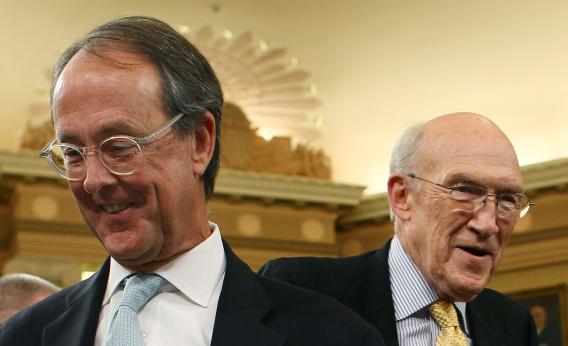The “Simpson-Bowles plan” is something you normally hear praised by centrist or center-right pundits, and while conservatives don’t really like it, the most vociferous opponents tend to be on the left. If you actually look at what the plan says, it becomes clear that this is about 85 percent about affect. As Suzy Khimm explains, as far as deficit reduction plans go, the Simpson-Bowles proposal is way to the left of anything Barack Obama’s put on the table. It’s much closer to being an American version of François Hollande’s left-wing austerity than a devious plot to gut the welfare state.
The key point is that while people say Simpson-Bowles features a 3-1 ratio of spending cuts to tax increases, it does this from a baseline that assumes full expiration of the Bush tax cuts.
When Barack Obama puts forward a 3-1 plan, the partial expiration of the Bush tax cuts that he favors is part of his one. Simpson-Bowles is taking a bigger tax hike than that, counting it as baked in the cake, and then implementing tax hikes on top of that. What’s more, Simpson-Bowles also implements steeper defense cuts than Obama has proposed. Part of what’s confusing people is that for technical reasons that Richard Kogan explains, Simpson-Bowles is also just much more overall austere than it initially seems. The way the plan is written they basically only count eight years of implementation inside the 10-year scoring window. If you count 10 years’ worth of implementation, then you have bigger budget cuts and bigger tax increases. So while getting to Obama’s left on taxes and military spending, Simpson-Bowles can also be harsher on some domestic programs.
But mostly what’s going on is affect, affect, affect, affect.
Even though the modern conservative movement has consistently enacted larger rather than smaller budget deficits when put into office, its members really enjoy the rhetorical posture of deficit scolding. Keynesian Democrats, meanwhile, think that any discussion of long-term fiscal policy challenges crowds out discussion of the need for short-term budget deficits. Last but by no means least, a very large share of the older cohort of political pundits is much too lazy and innumerate to be bothered to actually read the content of different policy proposals. The fact that Simpson-Bowles is a “bipartisan deficit reduction plan” makes it very appealing to them. If Alan Simpson and Erskine Bowles had agreed on a different time frame for a different amount of deficit reduction achieved through different methods, those exact same people would be praising it.
